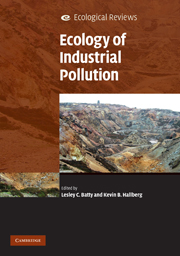Book contents
- Frontmatter
- Contents
- List of contributors
- Preface
- Acknowledgements
- 1 Consequences of living in an industrial world
- 2 Metallophytes: the unique biological resource, its ecology and conservational status in Europe, central Africa and Latin America
- 3 Lichens and industrial pollution
- 4 The impacts of metalliferous drainage on aquatic communities in streams and rivers
- 5 Impacts of emerging contaminants on the environment
- 6 Ecological monitoring and assessment of pollution in rivers
- 7 Detecting ecological effects of pollutants in the aquatic environment
- 8 With the benefit of hindsight: the utility of palaeoecology in wetland condition assessment and identification of restoration targets
- 9 An ecological risk assessment framework for assessing risks from contaminated land in England and Wales
- 10 Diversity and evolution of micro-organisms and pathways for the degradation of environmental contaminants: a case study with the s-triazine herbicides
- 11 The microbial ecology of land and water contaminated with radioactive waste: towards the development of bioremediation options for the nuclear industry
- 12 The microbial ecology of remediating industrially contaminated land: sorting out the bugs in the system
- 13 Ecological recovery in a river polluted to its sources: the River Tame in the English Midlands
- 14 Manchester Ship Canal and Salford Quays: industrial legacy and ecological restoration
- 15 Large-scale mine site restoration of Australian eucalypt forests after bauxite mining: soil management and ecosystem development
- 16 Sustaining industrial activity and ecological quality: the potential role of an ecosystem services approach
- Index
- Plate section
- References
2 - Metallophytes: the unique biological resource, its ecology and conservational status in Europe, central Africa and Latin America
Published online by Cambridge University Press: 05 June 2012
- Frontmatter
- Contents
- List of contributors
- Preface
- Acknowledgements
- 1 Consequences of living in an industrial world
- 2 Metallophytes: the unique biological resource, its ecology and conservational status in Europe, central Africa and Latin America
- 3 Lichens and industrial pollution
- 4 The impacts of metalliferous drainage on aquatic communities in streams and rivers
- 5 Impacts of emerging contaminants on the environment
- 6 Ecological monitoring and assessment of pollution in rivers
- 7 Detecting ecological effects of pollutants in the aquatic environment
- 8 With the benefit of hindsight: the utility of palaeoecology in wetland condition assessment and identification of restoration targets
- 9 An ecological risk assessment framework for assessing risks from contaminated land in England and Wales
- 10 Diversity and evolution of micro-organisms and pathways for the degradation of environmental contaminants: a case study with the s-triazine herbicides
- 11 The microbial ecology of land and water contaminated with radioactive waste: towards the development of bioremediation options for the nuclear industry
- 12 The microbial ecology of remediating industrially contaminated land: sorting out the bugs in the system
- 13 Ecological recovery in a river polluted to its sources: the River Tame in the English Midlands
- 14 Manchester Ship Canal and Salford Quays: industrial legacy and ecological restoration
- 15 Large-scale mine site restoration of Australian eucalypt forests after bauxite mining: soil management and ecosystem development
- 16 Sustaining industrial activity and ecological quality: the potential role of an ecosystem services approach
- Index
- Plate section
- References
Summary
Introduction
Metalliferous soils provide very restrictive habitats for plants due to phytotoxicity, resulting in severe selection pressures. Species comprising heavy-metal plant communities are genetically altered ecotypes with specific tolerances to, e.g., cadmium, copper, lead, nickel, zinc and arsenic, adapted through microevolutionary processes. Evolution of metal tolerance takes place at each specific site (Ernst 2006). A high degree of metal tolerance depends on the bioavailable fraction of the metal(loids) in the soil and the type of mineralization. At extremely high soil metal concentrations, especially on polymetallic soils, even metal-tolerant genotypes are not able to evolve extreme tolerances to several heavy metals simultaneously. Adapted genotypes are the result of the Darwinian natural selection of metal-tolerant individuals selected from surrounding non-metalliferous populations (Antonovics et al. 1971; Baker 1987; Ernst 2006). Such selection can lead ultimately to speciation and the evolution of endemic taxa. Heavy-metal tolerance was first reported by Prat (1934) in Silene dioica and demonstrated experimentally in grasses by Bradshaw and co-workers in Agrostis spp. and by Wilkins in Festuca ovina in the late 1950s and 1960s (see Antonovics et al. 1971) and from the early 1950s onwards in the herb Silene vulgaris by Baumeister and co-workers (see Ernst 1974). Metal-tolerant plants avoid intoxication by an excess of heavy metals by means of special cellular mechanisms, as long as the soil metal levels do not exceed the levels of metal tolerance (Ernst 1974; Ernst et al. 2004). They can thus thrive on soils that are too toxic for non-adapted species and ecotypes.
- Type
- Chapter
- Information
- Ecology of Industrial Pollution , pp. 7 - 40Publisher: Cambridge University PressPrint publication year: 2010
References
- 73
- Cited by



